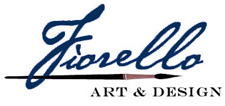 |
| Desdemona 8 x 10 oil painting by Pat Fiorello $300 |
This spring I ordered a new type of rose from the David Austin catalog, called Desdemona. It arrived in March and my husband planted it. It's doing well here in the Atlanta weather, but I was surprised when the flowers came out that they were so tiny. See photo below with my thumbnail for scale.
I was envisioning some big, beautiful cup/bowl-like flowers so was a little disappointed at the actual size. I wanted to paint them, so figured I could just make them look the size I had imagined in the painting.
When starting something that seems so complex, you really need to simplify to the major shapes and values. Don't get to the details/small shapes too fast. As one of my favorite artists and teachers, Robert Johnson often says ,"You have to earn your right to paint the petals". Meaning you have to get the structure of the whole painting and the flower first. The petals come later.
Or even better, forget about the idea of painting "petals" altogether. A painting never succeeds because of the tiny details, but because of the big overall shapes and composition. You need to attend to that first. Just like if you're building a house. You need to pour the foundation and put up the walls before you start buying curtains and assembling doorknobs.
A student recently was struggling painting a rose. She was judging herself (incorrectly concluding " I'm not good at painting flowers") and getting very discouraged. My advice to her was focus on the shapes of color/value you see and paint those shapes. Try to turn off your left brain that recognizes and labels everything as a petal, a leaf, a stem, a rose and look for shapes. If you can paint those abstract shapes and put them in the right relationship to one another, you'll paint something that looks familiar to the viewer, the pattern of light and dark shapes we associate with a rose. And they will interpret the spots of color you have put down on the canvas as a rose. You can never paint a real 3 dimensional rose, you can only paint the illusion of how we see a rose on your 2 dimensional canvas or paper.
As probably most artists have to, I had to go through this stage of moving from literal, left -brained thinking ( painting a rose) to artistic thinking ( painting the shapes of color that I see) myself. Many students struggle with this leap and change in thinking, so I cover it in my classes where appropriate. Below is a copy of the material I often share with students to help them transition from a literal reproduction of things to a more painterly creation of a painting with "shapes of color". Hope it is useful for you.
Shifting from literal
thinking to artistic thinking
(left
brained/analytical/intellectual to right brained/visual/spatial)
Which is more interesting, to read a love letter or an
itemized bill?
– Sergei Bongart
Art should be a love letter!
Literal thinking
|
Artistic Thinking
|
Paint things
|
Paint Shapes
|
Describe details
|
Suggest details
|
Put it in if its there
|
Select which
shapes/ elements add to your painting and which can be left out
|
Illustration
|
Painterly
|
Copy as is
|
Create as you want it to be
|
Ideas for getting to more artistic thinking, more painterly
paintings
-- Make sketches and work from the sketches rather
than the photo’s
-- Turn photo’s upside down to focus on shapes and paint upside
down
-- Put
photos away altogether
-- Work from b & w photo or value sketch or
Notan
-- Look for silhouettes of shapes, and make them
more interesting
-- Give yourself permission to move things around,
add or delete what’s needed for a better composition
-- Work from multiple photos’s so you’re not locked
on one.
-- Be on the lookout for repetitive shapes/marks-
cloning marks
-- Practice altering shapes. Modify boring shapes- -change
dimensions, change angle (oblique), have it interact with space around it-
interlocks/”incidents at the edge”
-- Be mindful of edges; hard, soft, lost, found;
harder near focal area, less defined further away from focal area
-- Vary colors within a shape- no need to have one
shape/one color
-- Use larger brush
-- Stand when painting, move from the arm, using
the brush as a shape maker, not like a pencil
-- Instead of things- house, tree, think shapes of
light, shapes of dark
-- Ask how the eye will move thru the painting, and
if composition is static, add movement, connecting darks, path of lights, entry
point, lines, pointers
-- Combine shapes of similar value into larger
shapes
We are striving for an engaging painting:
-Unity with Diversity
-Eye Movement
How the eye sees- focus in one area, blurry on the periphery
All rights reserved, Pat Fiorello 2015





No comments:
Post a Comment